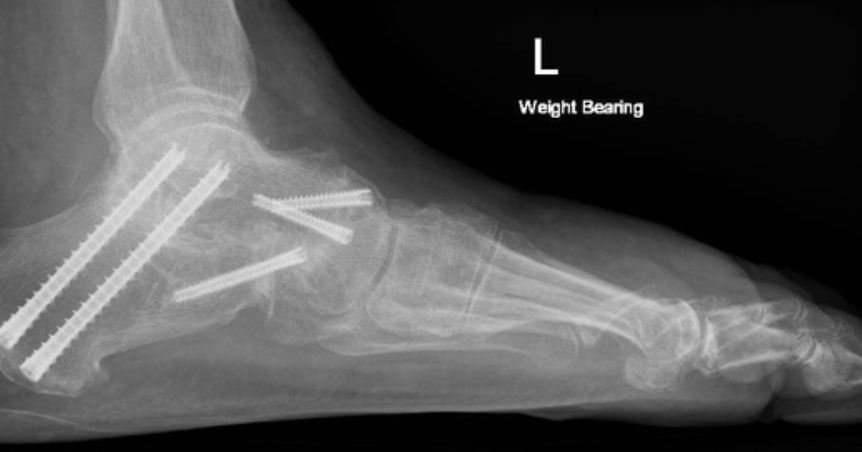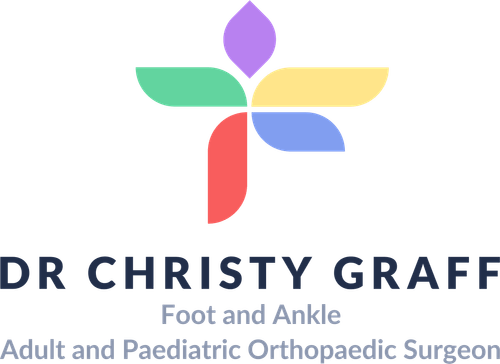Fusion of the Midfoot and Hindfoot
What is a Fusion of the Midfoot and Hindfoot?
Fusion of the midfoot and/or hindfoot is a surgical procedure to treat severe pain, deformity, or instability in these areas of the foot. This procedure involves permanently joining the affected bones using screws, plates, or rods to eliminate movement between the joints, thereby reducing pain and restoring alignment.

What Conditions Does a Fusion of the Midfoot and/or Hindfoot Help?
A Fusion of the Midfoot and Hindfoot helps in cases of severe trauma, deformity (such as from Charcot arthropathy), arthritis and/or instability of the foot and/or ankle.
Why is a Fusion of the Midfoot and/or Hindfoot Required?
This procedure is required when the inflammation and pain caused by chronic foot and ankle injuries are unresponsive to conservative treatment options, thus requiring surgical intervention to provide relief to the patient. Other reasons for this procedure are severe foot and/or ankle deformities that make walking or wearing shoes/orthotics difficult.
Indications for Fusion of the Midfoot and Hindfoot
Fusion of the Midfoot and/or Hindfoot surgery can benefit many patients with difficult foot and ankle conditions. However, it is a big operation and requires post-operative non-weight bearing for 6 weeks postoperatively. People suffering from a lung or heart condition or chronic disease such as uncontrolled diabetes are evaluated on a case-by-case basis before being considered eligible for this procedure. Patients who smoke, are unable to non-weight bear, or who have poor blood supply would not be able to have this procedure.
Benefits of Fusion of the Midfoot and Hindfoot
- Pain Relief: Fusion eliminates joint movement in the affected area, significantly reducing or eliminating pain caused by arthritis or instability.
- Improved Stability: The procedure creates a stable foot structure, which is crucial for walking and weight-bearing.
- Corrected Deformity: Fusion can restore proper alignment, improving the foot's functionality and appearance.
- Enhanced Mobility with Proper Shoes/Orthotics: Although the motion is lost, patients often regain functional mobility and experience less pain when wearing supportive footwear or custom orthotics.
- Long-Term Durability: Fusion provides a permanent solution for certain conditions, often resulting in long-term pain relief and improved quality of life.
Types of Fusion of the Midfoot and Hindfoot
The type of fusion performed depends on the specific joints and areas affected. Common types include:
- Midfoot Fusion: This technique targets the small joints in the midfoot, such as the naviculocuneiform or tarsometatarsal joints. It is often used for arthritis or instability in these joints.
- Subtalar Fusion: Focuses on the joint below the ankle (subtalar joint) to address conditions like arthritis or flatfoot deformity.
- Triple Arthrodesis: Involves fusing three joints: the subtalar, talonavicular, and calcaneocuboid joints. This is often used for severe deformities or arthritis affecting multiple joints in the hindfoot.
- Combined Midfoot and Hindfoot Fusion: In complex cases where multiple joints are affected, the midfoot and hindfoot may be fused simultaneously.
Alternative Options to Fusion of the Midfoot and Hindfoot
Before considering fusion, other treatment options may be explored:
- Non-Surgical Treatments
- Orthotics: Custom shoe inserts can support and relieve pressure on affected joints.
- Bracing: Ankle-foot orthoses (AFOs) or custom braces can stabilise the foot.
- Physical Therapy: Exercises and stretches to improve strength and mobility.
- Medications: Anti-inflammatory drugs or corticosteroid injections to manage pain and inflammation
- Lifestyle Modifications: Weight loss, proper footwear, and activity modification can reduce stress on the foot and alleviate symptoms.
- Joint-Sparing Surgery: Procedures that preserve joint function, such as joint realignment or cartilage repair, may be suitable for some conditions.
- Arthroplasty (Joint Replacement): Joint replacement may be an option for certain patients, particularly those with advanced arthritis who desire joint motion.
- Amputation: This is reserved for extreme pain, deformity and/or instability for those who have failed previous surgery, have a serious infection, or are not suitable for fusion surgery.
Preparation Before a Fusion of the Midfoot and Hindfoot
Fusion of the Midfoot and/or Hindfoot requires a preoperative medical evaluation. This evaluation consists of a complete patient history and physical examination to determine suitability for the procedure. It will also include lab tests and imaging, such as X-ray, CT, CT angiogram (to assess blood supply to the foot), and/or MRI. A referral to another specialist, such as a vascular surgeon or endocrinologist, may be needed to optimise patients for this surgery.
Fusion of the Midfoot and/or Hindfoot Procedure
The fusion is performed under general anesthesia. The steps include:
- Making the individual comfortable in the surgical suite
- Identification of the proper limb and joint and surgical draping
- Administration of general anesthesia
- Preparation of the joints that require fusion, which involves removing the cartilage and correcting the shape of the foot
- Insertion of screws, plates or rods to initiate fusion of the bones is performed.
- Repairing any soft tissue damage or imbalance if present
- Closing the incision with stitches, dressings, plaster or a boot and recovery from the anesthesia
The entire procedure can take a few hours.
The Hospital Stay
- Unless you have a circular frame, you wake up with a half plaster (back slab)
- Your foot will be elevated overnight, and you will have antibiotics through a drip.
- You will need blood thinners to prevent DVT
- You will use vitamin C to help with pain management and wound healing
- You will stay in the hospital for 2-5 days with antibiotics, blood thinners, regular paracetamol, regular laxatives, regular vitamin C and stronger painkillers to take if and when required
- You will be only allowed to touch your foot to the ground for 6 weeks
- Depending on your balance and strength, you may need rehabilitation post-operatively
- Buying a second-hand knee scooter preoperatively (you can search online) and practising at home before the surgery can be helpful; please bring it into the hospital with you. It is easier to use a knee scooter than crutches
When You Go Home
- You will need medications for pain relief; regular paracetamol (2 tablets four times a day) is recommended, as well as strong painkillers, especially at night before bed. These can have side effects of drowsiness, nausea and constipation, and other tablets to help with these side effects may be required.
- You will need blood thinners and vitamin C as prescribed
- You will need a shower chair and bags to keep the plaster dry
- You will need to attend your post-op appointment in 2-3 weeks, where the wounds will be checked and your plaster changed to a waterproof cast if your wounds are healed
- After this, you will be able to shower with a shower chair and get the plaster wet
Ankle Fusion Surgery Rehabilitation
All patients are different, and these timelines are only guides. Some may progress faster or slower than others.
0 - 2 Weeks
- You will be in a back slab for 2-3 weeks
- You can only touch your foot to the ground for balance.
- Please keep your foot elevated and out of bed for toilet only
- You will need to bag the leg for showers
- Pain relief: Please take regular paracetamol with meals and before bed; stronger painkillers are often needed, especially before bed
- Please take aspirin 150mg daily or clexane for 6 weeks
2 - 3 Weeks
- Post-op appointment with Dr Graff: dressings are changed, and an x-ray is taken
- You will then go into a full cast (often waterproof if the wounds are okay) for another 3-4 weeks
- You will still need to elevate the foot at rest
- You can start static strengthening and balance exercises with physio
6 Weeks
- You will have an appointment with Dr Graff and an x-ray
- The cast will be removed, and you can start weight-bearing in a boot for 6 weeks
- You can continue static strengthening
12 Weeks
- You will have another appointment with Dr Graff and an x-ray;
- You can start the range of motion and weight bearing without the boot
- You will still have ongoing swelling, so you may not fit into normal shoes, but you can wear normal shoes if you can fit into them (It would be good to wear rocker bottom shoes postoperatively)
- You can start swimming and cycling
6 Months
- You will have another appointment with Dr Graff and an X-ray
- You will be feeling more ‘yourself’ and improved pain relief in the ankle
12 Months
- You will have another appointment with Dr Graff and an X-ray
- If the bones are fused, you may be discharged
When can I drive?
- Left foot 8 weeks
- Right foot 12 weeks
When can I return to work?
- Seated work at 2-3 months
- Prolonged standing 8-12 months
- Heavy labour work 12-18 months
Fusion of the Midfoot and/or Hindfoot Prognosis
The success rate of midfoot and hindfoot fusion is generally high, with studies indicating a bone fusion rate of approximately 90–95%.
Patients often experience significant pain reduction and improved foot stability post-surgery. However, the extent of functional improvement can vary based on factors such as the severity of the initial condition, adherence to postoperative care protocols, and individual healing responses. While the fused joints will no longer move, many patients adapt well and can return to daily activities. It is important to note that the foot and/or ankle are now much stiffer but in a better position without painful joint movement.
Fusion of the Midfoot and/or Hindfoot Risks
Fusion of the Midfoot and/or Hindfoot carries all the risks associated with surgery, such as infection, blood clots, bleeding and a severe allergic reaction to anesthesia. There is also a risk of nerve injury, chronic pain, delayed healing of the wound, the fusion not healing or healing in a poor position, and re-operation
Implications of Delaying Fusion Surgery
Postponing recommended fusion surgery can result in the following:
- Progressive Deformity: The underlying condition may worsen, leading to increased deformity and more complex surgical correction later.
- Increased Pain: Delay can lead to prolonged discomfort and a reduced quality of life.
- Joint Degeneration: Ongoing damage to the affected joints can occur, potentially affecting adjacent joints and complicating future treatment options.
Contact Us
If you want more information or have any questions or problems, please contact Dr Graff at admin@christygraff.com or call the rooms at 0493 461 133.
